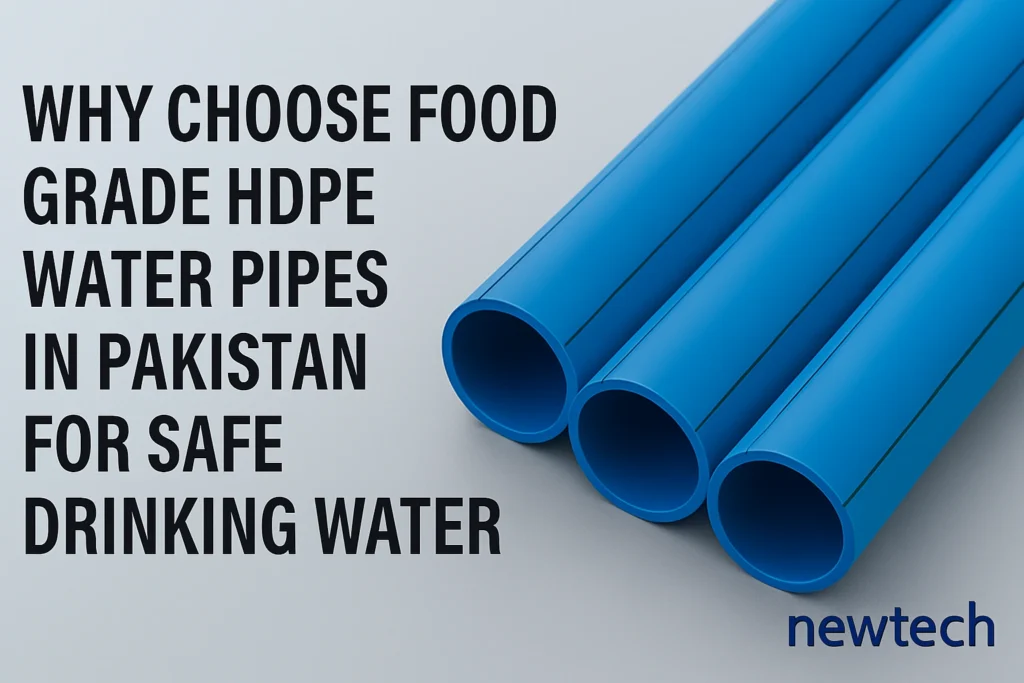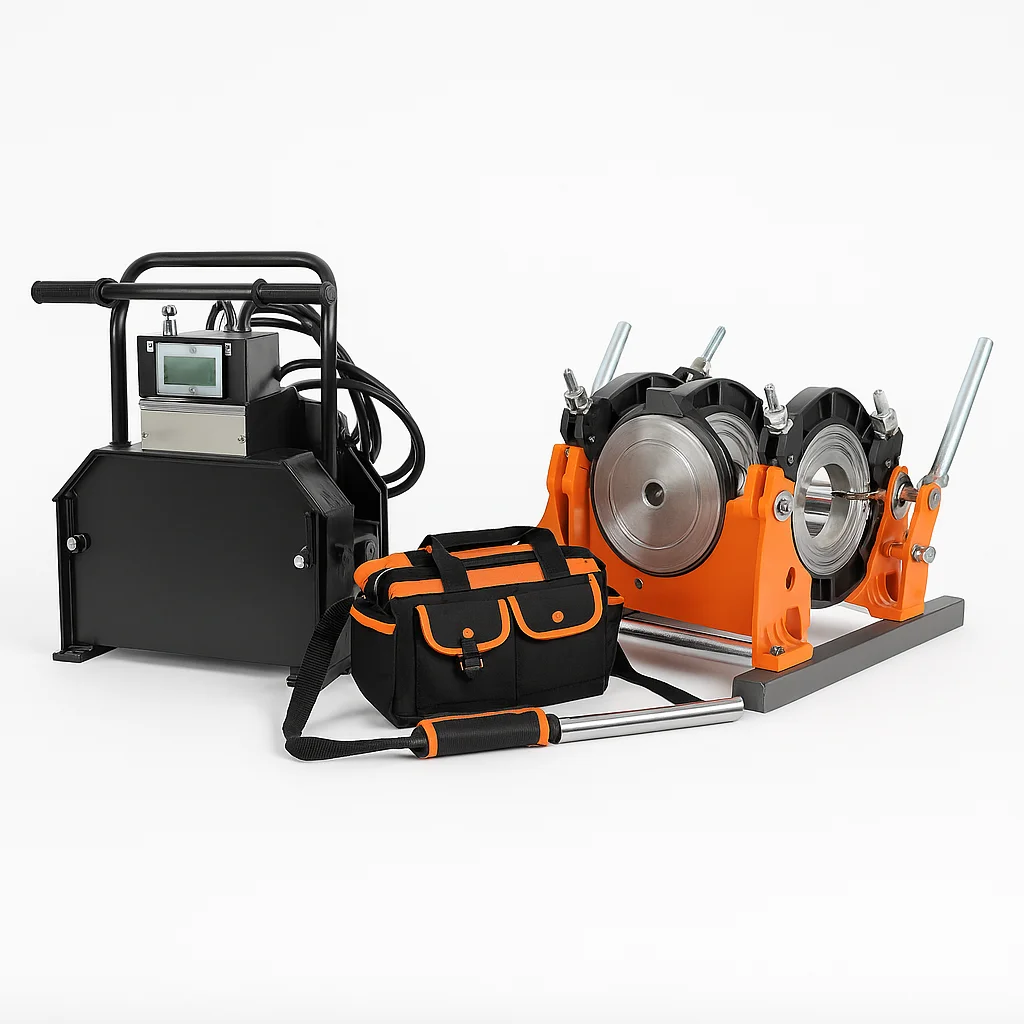If you care about the safety of your drinking water supply, you’ve probably heard of food grade HDPE water pipes in Pakistan. But what exactly makes them “food grade,” and why are they becoming the preferred choice for homes, communities, and industries across Pakistan? Let’s explore how these pipes ensure safe, clean water and what to look for when buying them.
What is a food grade HDPE water pipe?
A food grade HDPE (High-Density Polyethylene) water pipe is made from virgin, food-grade PE100 or PE80 resin that meets strict safety standards for transporting drinking water. “Food grade” means the material does not leach harmful chemicals or alter the taste, smell, or quality of the water it carries.
These pipes are designed to meet international potable water standards (such as ISO 4427 and NSF/ANSI 61) and local PSQCA regulations in Pakistan. They often have blue stripes or solid blue coloring to indicate their suitability for drinking water.
HDPE Butt-Fusion Welding Machines
How is food grade HDPE different from regular HDPE?
While both are made of high-density polyethylene, food grade HDPE must pass additional safety and hygiene tests.
- Raw Material: Only virgin resin is used (no recycled plastic).
- Chemical Safety: Certified free from toxins like BPA and heavy metals.
- Taste & Odor Neutrality: Doesn’t impart any flavor or smell to water.
- Production Standards: Manufactured in clean facilities under strict quality control.
Regular HDPE pipes for irrigation or drainage may not meet these standards, and using them for drinking water could risk contamination.
Why is food grade HDPE the preferred choice for potable water in Pakistan?
Several factors make it the first choice for safe water delivery:
- Health Safety: Non-toxic, compliant with health standards.
- Durability: Resistant to corrosion, scaling, and bacterial growth.
- Flexibility: Can handle ground movement without cracking.
- Leak-Free Joints: Butt fusion or electrofusion welding ensures strong, sealed connections.
- Long Life: Can last 50+ years when properly installed.
- Cost Efficiency: While initial price may be higher than PVC, lower maintenance and longer service life save money long-term.
Where are food grade HDPE water pipes used in Pakistan?
- Residential Water Supply: From main lines to household connections.
- Municipal Water Networks: Long-distance mains for city supply.
- Rural Water Schemes: Supplying villages with safe water.
- Industrial Use: Where potable water is needed for processing.
- Hotels, Schools, and Hospitals: Ensuring hygienic drinking water.
What standards should you check before buying?
Always confirm that the pipes are certified for potable water use:
- PSQCA Certification: Mandatory in Pakistan for water pipes.
- ISO 4427 Compliance: International standard for polyethylene pipes for water supply.
- NSF/ANSI 61: Ensures no harmful leaching into drinking water.
- Batch Traceability: Printing on the pipe should show manufacturer, date, size, SDR, and certification marks.
How do you identify genuine food grade HDPE pipes in the market?
- Look for Blue Markings: Either solid blue or black pipe with blue stripes.
- Check for Printed Specs: Size, SDR, PE grade, and certification info should be visible.
- Ask for Test Reports: Verify recent pressure and chemical safety tests.
- Buy from Trusted Suppliers: Avoid unbranded or uncertified products.
- Inspect the Finish: Should have smooth inner walls and consistent coloring
What sizes and pressure ratings are available in Pakistan?
Food grade HDPE water pipes come in a wide range:
- Diameter: From 20 mm for small domestic lines up to 500 mm+ for municipal mains.
- SDR (Standard Dimension Ratio): SDR11, SDR13.6, SDR17, SDR21, SDR26—lower SDR = thicker wall = higher pressure rating.
- PN (Pressure Rating): PN6, PN10, PN12.5, PN16—match the rating to your system’s pressure.
What affects the price of food grade HDPE water pipes in Pakistan?
- Diameter & Wall Thickness: Larger, thicker pipes cost more per meter.
- Material Grade: PE100 is often more efficient than PE80 for the same pressure rating.
- Certification: Fully certified potable water pipes may cost slightly more.
- Market Conditions: Resin price, currency exchange rate, and demand can affect rates.
- Supplier Location: Delivery costs vary based on distance from the manufacturing site.
How is a food grade HDPE pipeline installed?
The process involves:
- Trenching: Excavating to required depth.
- Bedding: Laying a sand or fine soil bed.
- Pipe Placement: Aligning pipes to design layout.
- Jointing: Using butt fusion or electrofusion welding for leak-proof joints.
- Backfilling: Covering with protective material and compacting.
- Testing: Hydrostatic pressure testing to confirm performance.
- Disinfection: Flushing with chlorinated water before use.
What maintenance do food grade HDPE water pipes need?
One of the biggest advantages is minimal maintenance. Once installed correctly:
- No Internal Corrosion: Reduces risk of blockages.
- Leak Resistance: Fused joints minimize leakage.
- Easy Repairs: Sections can be replaced with electrofusion fittings if needed.
- UV Resistance: Some grades include UV stabilizers for above-ground exposure.
Can food grade HDPE be used in both cold and hot water systems?
For cold and ambient-temperature water—yes. For hot water, HDPE can handle certain temperatures, but for continuous high-temperature supply, materials like PPR are more suitable. Always check the manufacturer’s specs for temperature limits.
How does food grade HDPE compare with PVC for drinking water?
- Safety: HDPE is inert and chemical-free; PVC may contain additives.
- Joint Integrity: HDPE fusion joints are leak-proof; PVC relies on solvent welding or rubber rings.
- Longevity: HDPE offers superior lifespan in underground installations.
Wrap-up
Food grade HDPE water pipes in Pakistan are a smart choice for anyone who values clean, safe drinking water and long-term reliability. Whether you’re building a new home, upgrading a rural water system, or managing a large municipal network, these pipes deliver safety, durability, and cost efficiency. The key is to choose certified products, buy from trusted suppliers, and ensure proper installation to get decades of trouble-free service.
Frequently Asked Questions (FAQs)
1) Is food grade HDPE pipe safe for drinking water in Pakistan?
Yes, when certified to potable water standards, it’s safe, non-toxic, and widely used.
2) How long does a food grade HDPE water pipe last?
Typically 50 years or more with proper installation and use.
3) Does food grade HDPE change the taste of water?
No—it’s designed to be taste- and odor-neutral.
4) Can I use food grade HDPE for underground and above-ground water supply?
Yes, though above-ground installations should use UV-stabilized grades.
5) What’s the difference between PE80 and PE100 in food grade HDPE pipes?
PE100 allows thinner walls for the same pressure rating, which can save weight and cost while maintaining strength.



